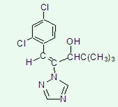| Product name: |
Diniconazole |
| Alias: |
(E)-(RS)-1-(2,4-dichlorophenyl)-4,4-dimethyl-2-(1H-1,2,4-triazol-1-yl)pent-1-en-3-ol; (E)-(-b-[(2,4-dichlorophenyl)methylene]-a-(1,1-dimethylethyl)-1H-1,2,4-triazole-1-ethanol
|
| Chemical name: |
(E)-(RS)-1-(2,4-dichlorophenyl)-4,4-dimethyl-2-(1H-1,2,4-triazol-1-yl)pent-1-en-3-ol
|
| CAS No.: |
83657-24-3 |
| Molecular formula |
C15H17Cl2N3O
|
| Structural formula : |
 |
| Property : |
Form Colourless crystals.
Melting point 134-156℃.
Density 1.32 (20℃).
Solubility In water 4 mg/l (25℃). In acetone, methanol 95, xylene 14, hexane 0.7 (all in g/kg, 25℃).
|
| Toxicity : |
Oral Acute oral LD50 for male rats 639, female rats 474 mg/kg.
Skin and eye Acute percutaneous LD50 for rats >5000 mg/kg.
Mild eye irritant; non-irritating to skin (rabbits). Not a skin sensitiser (guinea pigs).
Inhalation LC50 (4 h) for rats >2770 mg/m3.
|
| Product use : |
Control of leaf and ear diseases (e.g. powdery mildew, Septoria, Fusarium, smuts, bunt, rusts, scab, etc.) in cereals; powdery mildew in vines; powdery mildew, rust, and black spot in roses; leaf spot in peanuts; Sigatoka disease in bananas; and Uredinales in coffee. Also used on fruit, vegetables, and other ornamentals.
|
| Quality index : |
Description: Gray to white powder, free from visible extraneous matter;
Active Ingredient Content(w/w): ≥95%;
Water (w/w): ≤0.5%; pH Range: 5.0~8.0;
Acetone Insoluble Material(w/w): ≤0.5%
|
| Standard : |
GB 22175-2008 |
| Packing: |
25Kg Fiber drum |
| Formulation: |
12.5%WP; 50%WG; 5% DS;125g/L, 250g/L EC/ME |
| Attention : |
Preserve in well-closed container at ventilated, dry place. |
|


